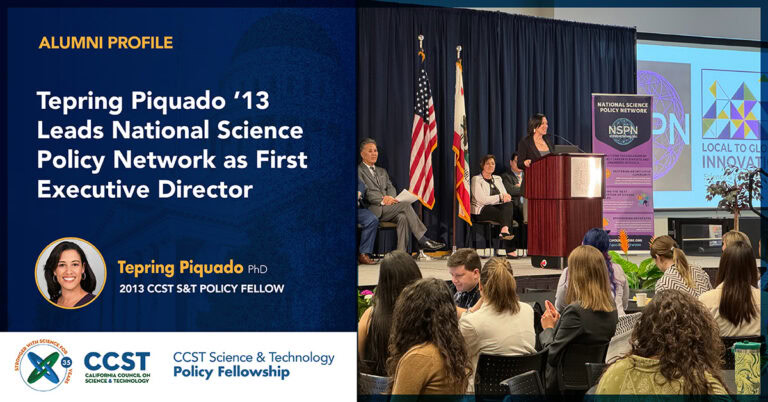Development Specialist
‘Innovate 2 Innovation’ Envisions Resurgent California
August 17, 2011 | CCST Newsroom, Press Releases | Contact: Will Holbert
In a not too distant California future, students experience classrooms as a rich, multimedia virtual concept instead of a physical space. They graduate into a workforce and marketplace that thrives on the seamless, constant conversion of intellectual ability into economic power. Part of that workforce successfully applies the latest technology solutions to ensure water quality, restore watersheds, repair habitats and develop new products and services that address California’s water challenges.
California is back, having recaptured its role as global leader in innovation. A lofty goal in a California presently defined by budget challenges and economic morass, but entirely within the state’s reach if it follows a detailed plan, such as one outlined in a report to the California Legislature released today by the California Council on Science and Technology (CCST).
“Innovate 2 Innovation,” or “i2i,” presents an action plan that would restore California’s magnetic attraction for talent and unparalleled reputation for scientific research and high technology.
“This report is timely, as California’s leaders determine how best to nurture the innovations that will grow our economy,” said Senate President pro Tem Darrell Steinberg. “CCST’s report reassures us about what’s right with California – the assets on which we can build, to ensure California continues to enhance its science and technology industry from the classroom to the workplace. At the same time, it maps out thoughtful recommendations to address the fundamental challenges to California’s future competitiveness. We look forward to reviewing these recommendations.”

To underline i2i’s call for innovation, CCST deployed a remote response medical robot, RP-7, that delivered i2i to a gathering of California legislators in Room 1190. Remotely piloting the robot from the Santa Barbara headquarters of InTouch Health was company founder Yulun Wang, precisely the type of high-tech entrepreneur i2i has in mind for a resurgent California. Appearing on the robot’s head-mounted monitor, Wang literally put a face on the i2i report’s mission and purpose.
The i2i report was produced by the California Council on Science and Technology and facilitated by Collaborative Economics. The work was co-Chaired by Julie Meier Wright, who served as the first secretary of California’s Trade and Commerce Agency, and Charles Kennel, Distinguished Professor of Atmospheric Science, Scripps Institution of Oceanography. Mohammed Qayoumi, president of San Jose State University and Anne Marie Bergen, Teacher in Residence, Cal Poly, San Luis Obispo, led the education action team and Jude Laspa, former Executive Vice President and Director Bechtel Group, Inc. led the water innovation action team. Producing the report involved tapping into the creative spirits of thought leaders from throughout the State.
“California risks losing its place at the forefront of innovation, in the nation and in the world. We need to recharge the connectivity between industry, science and education to regain that position, and i2i is a set of instructions for achieving that objective,” Wright said.
The i2i report lays out a three-pronged strategy that would strengthen collaboration between industry and higher education, transform K-12 education into a robust and digitally-driven learning environment, and apply technology to resolving California’s water issues at a level unknown today. Lt. Governor Gavin Newsom, who recently unveiled “An Economic Growth and Competitiveness Agenda for California,” recognized the role of innovation in delivering California’s Next Economy.
“Leadership in innovation is absolutely essential to the economic growth and prosperity of California. The recommendations outlined by the California Council on Science and Technology will help ensure that our state becomes more competitive in the 21st Century Economy. I encourage the state legislature to make these recommendations a top priority,” said Newsom.
First, a California Innovation Corporation, or CIC, would provide a cohesive setting for academic and industry leaders to work more closely together. Funded privately, the Corporation would promote the commercialization of innovative products and development while nurturing talent. By building a stronger and larger base of researchers and entrepreneurs, California’s faltering economy could again find its footing and speed economic growth.
“Innovation-based models will help California prosper in the post-recession economy, strengthening our human and physical infrastructure and spurring the development of new technologies and products,” said V. Manuel Pérez (D-Coachella), chair of the Assembly Committee on Jobs, Economic Development and the Economy. “By prioritizing innovation, we recommit to our workers, businesses, and communities that California will remain a dominant player in the global economy, attracting new private investment and creating jobs well into the 21st century.”
Illustrating the need for more innovative leadership, i2i paints a stark picture of California’s current status. In a trend described as “alarming,” California trails other states in rates of growth. In 2004, the combined 39 million population of Texas, Virginia and Washington included 213,000 engineers. By 2008, the number of employed engineers had grown by 43,000. California, with roughly the same population, introduced about half as much engineers into its workforce, despite its longtime role as the epicenter of global high-tech industry.
The CIC would focus energy on closing that gap on several levels in addition to building up the number of engineers and scientists in California. Along with widening channels of cooperation between academia, research labs and industry, it would support entrepreneurial leadership and strive to improve the state’s business climate for innovation industries.
The i2i report will be reviewed by the Assembly’s new Select Committee on Job Creation for the New Economy.
“The Committee will make it a priority to review CCST’s recommendations for California’s leadership in innovation, the cornerstone of what we need to succeed in the new economy,” said Assemblymember Nathan Fletcher, who was just appointed by the Speaker of the Assembly to chair the new committee.
If adopted, i2i’s recommendations on K-12 education would likely become its most visible, widespread and dramatic difference in day-to-day life in California. It calls for every California child to have access to broadband capability. Under this scenario, students would interact with teachers and explore subjects through mobile phones and laptops inside and outside of a classroom.
Students would study math and science, but through groundbreaking new courses that would depart from traditional teaching methods and prepare them for life in the mid 21st century. Subjects could include Information and Media Literacy, and Economics, Business and Entrepreneurial Literacy.
Achieving this would require revamping California’s Education Code, which actually works to block advances in digitally enhanced education, according to i2i. Related to this is removing a roadblock to complete implementation of new standards adopted in 2010 for math, English, science and social science literacy, currently hung on a state moratorium that delays developing new instructional materials until at least 2015. It would also require a robust amount of private investment and enhanced publicprivate partnerships. Leading the effort would be an organization similar to the CIC, a California Education Innovation Consortium.
“We’re still spending too much time preparing students for the 1990s instead of 2020 and beyond. Fortunately, many of the necessary advances in education are already in place, ready to implement, provided certain barriers are removed. Within a few years, the seeds of an economic revival for California could be growing in the minds today’s elementary school students,” said Bergen, who led i2i’s education team.
In addition to radical changes in education, the California economy requires an innovative, more high-tech approach to what’s become a perennial no-win dilemma – water. However, i2i envisions a way out through a 10, 25 and 50-year road map. Again calling for a mixture of public and private funding, i2i outlines how science and technology should play a bigger role in forecasting water availability and demand, ensuring water quality and restoring watersheds and riparian habitats. This can be accomplished through a more aggressive use of satellite monitoring, membrane and filtration technology and sensor technology.
A Water Road Map would be similar to the CCST’s recently issued “California’s Energy Future,” which filled in numerous blanks about ways the state could fulfill its goal of mostly emissions-free energy generation by 2050.
“Water is a common denominator that’s driving so many trends in California’s economic vitality, livability and capability to grow. The innovation we need to foster is the same innovation that can balance water supply, with water demand, and water quality,” said Susan Hackwood, the executive director of the CCST.
Hackwood also noted that innovation-driven focus in education and water can lead to new, job-creating private investment in California.
The CCST is a nonpartisan, impartial, nonprofit created in 1988 by a unanimous vote of the California Legislature. It is designed to offer expert advice to the state government and to recommend solutions on science and technology-related policy issues. The CCST is governed by a board of directors composed of representatives from its sponsoring academic institutions, from the corporate and business community, as well as from the philanthropic community.
###






